The Leadtek WinFast PX6800 GT TDH is a great high-end video card for anyone looking for one, especially if you want potentially great overclocking right out of the box. To help consumers see what they get for about twice the price, this review takes a look this GeForce 6800 GT card from Leadtek and compares it to a GeForce 6600 GT card.
Introduction
Every so often I like to do a review where I compare a high-end video card to a top-shelf mid-range card so that consumers can see what they get for usually about twice the price. The main focus of this review will be the Leadtek WinFast PX6800 GT TDH, but the secondary theme will be this comparison. I recently reviewed the Gigabyte 6600 GT, which is definitely a great mid-range card that many people would love to have. Thanks to Leadtek, I now have a 6800 GT that will allow me to do this high-end to mid-range comparison. Obviously, the 6800 GT should slap around the 6600 GT like a freshman in a locker room. That will not surprise anyone. The main thing I want to look at is if the price premium that the 6800 GT demands is worth it. For example, if 6800 GT performs less than 20% better than the 6600 GT on the majority of the benchmarks, perhaps paying twice as much for the higher-powered GPU is not worth it.
Besides the GeForce 6800 GT GPU and its set of features, the Leadtek WinFast PX6800 GT TDH features 256 megabytes of GDDR3 memory, a custom cooler, and two DVI outputs. The board sports a 16-lane (x16) PCI Express interface and requires the slot next to the x16 slot to be free due to its large cooler’s size. As with all NVIDIA-based GT and Ultra boards, the PX6800 GT has an SLI connector to allow you to run two of them in tandem; however, I am not sure that two of these could fit side-by-side on all SLI-equipped motherboards. Unfortunately, I don’t have the means to test that, but I thought I should point out the concern so that potential buyers can be aware. (EDITORS NOTE: THERE IS ENOUGH ROOM ON SLI BOARDS FOR THESE CARDS)

Specifications & Features
Specifications:
| Graphics Chip | NVIDIA GeForce 6800 GT |
| Memory | 256 MB GDDR3 |
| Memory Bus | 256-bit |
| Core Clock | 350 MHz |
| Memory Clock | 1000 MHz (effective) |
| Maximum Resolution | 2048 x 1536 @ 75 Hz |
| Bus Interface | PCI Express x16 |
| Pixel Pipelines | 16 |
| Vertex Shaders | 6 |
| Output Options | 2x DVI (can be converted to VGA using included adapters) TV-Out |
Features:
- GeForce 6 Series
- 16 parallel rendering pipelines
- Dual 400MHz RAMDACs
- Two DVI outputs
Package Contents:
- GeForce 6800 GT Video Card
- WinFast Graphics Series Quick Installation Guide
- WinFast Graphics Series General Guide
- 2 DVI-to-VGA adapters
- S-Video cable
- Composite video cable
- S-Video to composite adapter cable
- Driver installation disc, which also includes:
- WinFast DVD
- Muvee 3
- Coloreal Embedded, Visual, and Bright
- WinFox 2.0
- Cycore Cult3D
- Full Version Games:
- Splinter Cell: Pandora Tomorrow
- Prince of Persia: Sands of Time
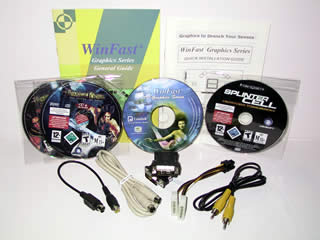
The Board
Leadtek equipped its 6800 GTs and Ultras with a rather large cooling unit. As you can see, most of the size comes from the main heatsink on the front of the card. But Leadtek also covered a large portion of the back of the board with a heatsink that is larger than the simple plates that I’ve seen on most 6800 GTs. I’m not sure why Leadtek did this since all of the RAM chips and the GPU are on the front of the board. The heatsink must aid in the cooling enough for Leadtek to think it is worth it.
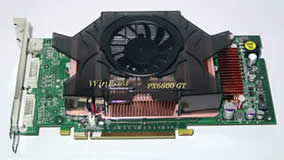 |
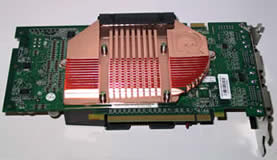 |
The next two pictures provide another good look at why this board is a two-slotter.
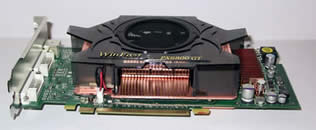 |
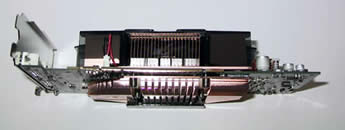 |
The last pictures show the PCI Express power connector, the two DVI connectors, and the TV-out connector. Leadtek provides an adapter for power supplies that do not include the relatively new 6-pin PCI Express power connector.
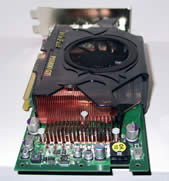 |
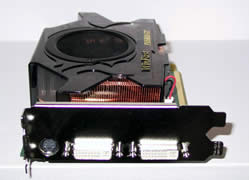 |
Performance
One important thing to keep in mind is that in order to make a high-end graphics board worth its price, a system with a high-end CPU is usually required. Without a high-end CPU backing it up, a high-end GPU will not be able to perform at its peak because the CPU can become the bottleneck, hindering the graphics processors performance. An Athlon 64 3500+ or the P4 550 in my test system are good examples of high-end CPUs that are good companions for high-end video cards.
You will see three important sets of performance data in this article. First, I have included the usual comprehensive set of benchmarks below. Following the standard benchmarks, I present overclocking results so that you can get a feel for how Leadtek’s huge cooler aids in overclocking. And, in the conclusion section, I have a table that summarizes the performance gain from the 6600 GT to the 6800 GT in the standard benchmarks. Together, this data should illustrate the PX6800 GT’s overclockability and its performance as compared to the mid-range GeForce 6600 GT.
Test System Configuration
- Intel Pentium 4 550 (3.4 GHz) (article)
– Hyperthreading Enabled - Gigabyte GA-8GPNXP Duo (review)
- OCZ EB DDR PC3200 1 GB kit – 2 x 512MB (review)
- Seagate Barracuda 7200.7 SATA NCQ 160GB hard drive (article)
- Leadtek WinFast PX6800 GT TDH -or- Gigabyte 6600 GT (review)
- Microsoft Windows XP with Service Pack 2
- Forceware 66.93, DirectX 9.0c
3DMark03 (3.5.0)
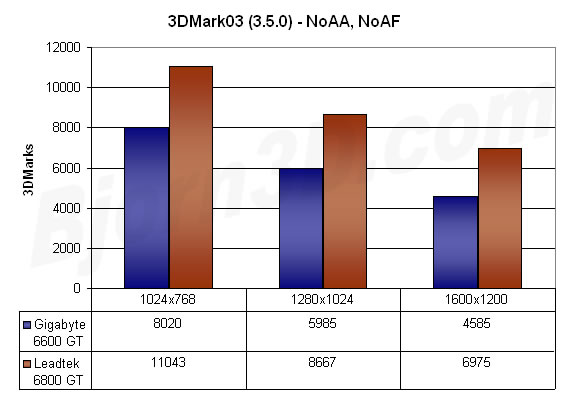
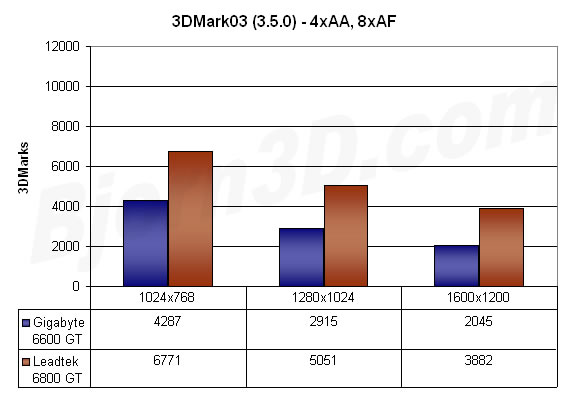
3DMark05 (1.1.0)
3DMark05 was designed for the current generation of boards and beyond. If you’ve tried to run this benchmark on an older generation video card, you definitely know what I mean. 3DMark05 requires DirectX 9.0 compliant hardware to render its high-quality scenes. It features various complex lighting scenarios and large- and small-scale environments that really push current hardware to its limits.

AquaMark3
The AquaMark3 benchmark utilizes a real 3D game engine (called krass) with DirectX 9.0 features, such as Pixel Shaders 2.0, to render a beautiful underwater world. This engine is used in AquaNox 2: Revelation and the RTS game Spellforce. I ran the default benchmark (1024×768, No AA, 4x AF, maximum details) that can be run in an unlicensed version of AquaMark3 and two benchmarks with custom settings – Very High level of detail, 4xAA, and 8xAF at both 1024×768 and 1280×1024.

Doom 3 (1.1)
Doom 3 has a reputation for being a power hungry PC game. Since its advanced graphics features include bump mapping, specular and diffuse lighting, shadows, and volumetric fog, Doom 3 can really test the might of any system. One important thing to keep in mind is that 8x anisotropic filtering is enabled automatically when the “High Quality” setting is selected.
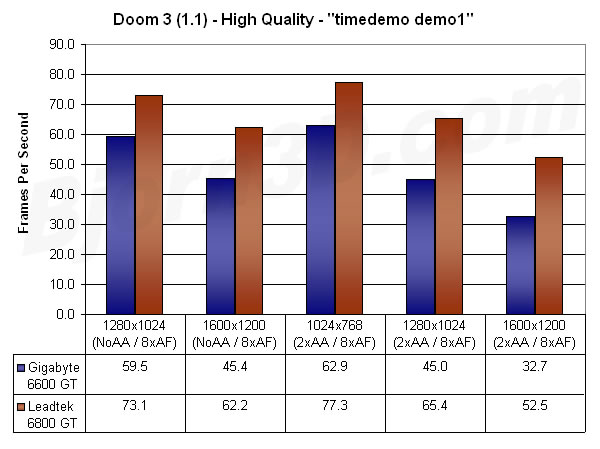
Halo (1.06)
I ran Halo 1.06 and used the timedemo feature for these benchmarks. The timedemo feature does not really provide a realistic in-game performance number; I would compare it to a flyby type of benchmark. Nevertheless, it provides some idea of how the these boards will perform in this game.
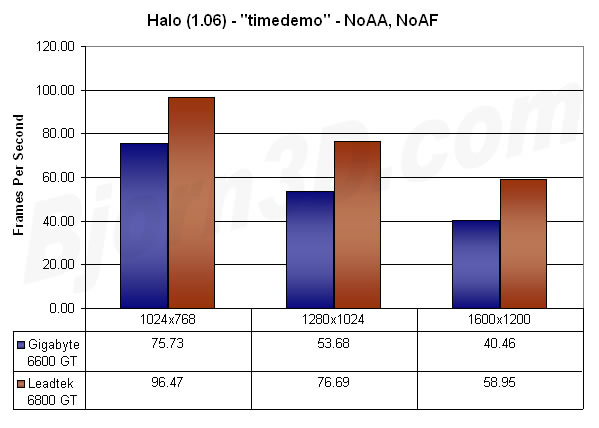
Far Cry (1.3)
Far Cry is a very popular game from Crytek, and just like Doom 3, it can test the might of nearly any system. To benchmark using the time demo feature of Far Cry, I used the PCGH_VGA Timedemo from 3dcenter. In the advanced graphics settings area of the game configuration screen, the lowest that anisotropic filtering can go is 1x, which means that at least 1xAF is enabled at all times. All other detail settings where set to High for all timedemo runs.
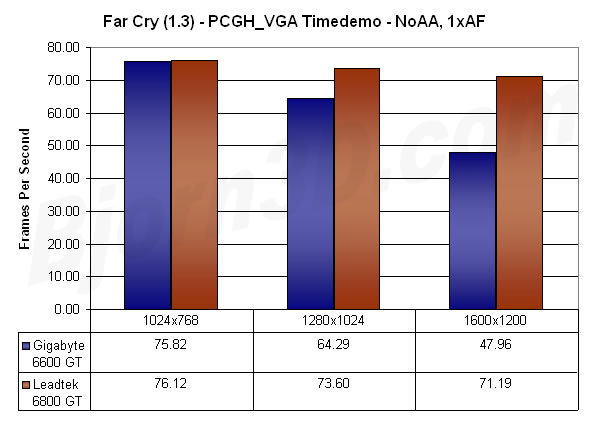

Source Visual Stress Test
The Source Visual Stress Test is an option in Valve’s very popular Counter-Strike: Source game. It is simply a flyby technology demo for the Source engine, but it provides a easy way to gauge relative performance of video cards for games based on the Source engine, such as Half-Life 2.
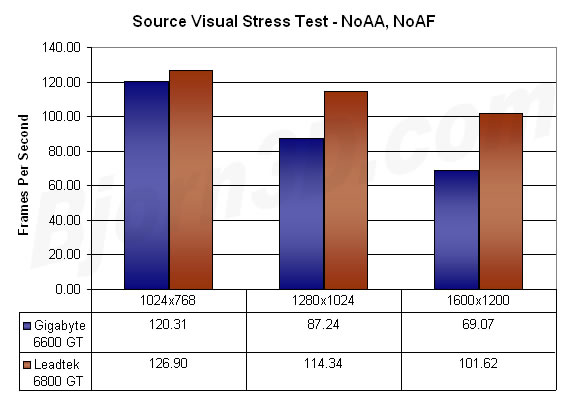
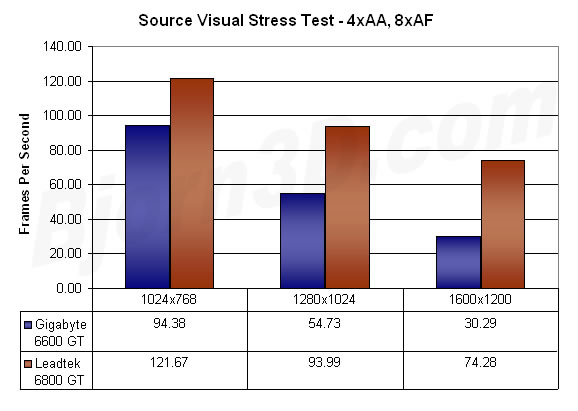
Overclocking
To overclock the Leadtek WinFast PX6800 GT TDH, I used the “coolbits” registry tweak that allows users to specify clock frequencies in NVIDIA’s driver panel. I clicked the “Detect Optimal Settings” button thinking that it would give me mediocre results, since it usually seems to be a little bit conservative. However, I was pleasantly surprised that the core and memory clocks were set to 418 MHz and 1.13 GHz, respectively, after it finished its detection. Remember that the default clock speeds for a 6800 GT are 350 MHz for the core and 1.00 GHz for the memory clock. The overclocking results that I experienced actually put this card at slightly faster clock speeds than the defaults for a 6800 Ultra, which are 400 MHz and 1.10 GHz.
I ran a few of the benchmarks at high-detail settings again to see how much of an improvement these new clock speeds could yield. Here are the results:
|
PX6800 GT (350/1000) |
PX6800 GT (418/1130) |
% Increase |
|
| 3DMark03 (3.5.0) 1024×768, 4xAA, 8xAF |
6771 | 7840 | 15.8 |
| 3DMark03 (3.5.0) 1600×1200, 4xAA, 8xAF |
3882 | 4543 | 17.0 |
| 3DMark05 (1.1.0) 1024×768, NoAA, NoAF |
4580 | 5315 | 16.0 |
| 3DMark05 (1.1.0) 1024×768, 4xAA, 8xAF |
3720 | 4363 | 17.3 |
| Doom 3 (1.1) High Quality (8xAF), 1024×768, 2xAA |
77.3 | 80.1 | 3.6 |
| Doom 3 (1.1) High Quality (8xAF), 1600×1200, 2xAA |
52.5 | 60.0 | 14.3 |
| Source Visual Stress Test 1600×1200, 4xAA, 8xAF |
74.28 | 86.14 | 16.0 |
Considering the core was overclocked 19.4% and the memory 13.0%, these results seem reasonable. The CPU must have been the limiting factor for the lower resolution Doom 3 benchmark, since it does not fit the pattern of the rest of the results. As usual, overclocking experiences will vary, but this at least shows that Leadtek’s super-sized cooler could add value to the card by aiding in its overclockability.
Conclusion
A trend that was not surprising at all was that the performance of the Leadtek WinFast PX6800 GT TDH really distanced itself from the 6600 GT at high resolutions with anti-aliasing and anisotropic filtering enabled.
|
Avg % Gain from |
Max % Gain from |
|
| 3DMark03 | 59.28% | 89.83% (1600×1200, 4xAA, 8xAF) |
| 3DMark05 | 47.05% | 58.10% (1024×768, 4xAA, 8xAF) |
| AquaMark3 | 21.16% | 31.96% (1280×1024, 4xAA, 8xAF) |
| Doom 3 | 37.73% | 60.55% (1600×1200, 2xAA, 8xAF) |
| Halo | 38.66% | 45.72% (1600×1200) |
| Far Cry | 29.66% | 53.45% (1600×1200, 2xAA, 4xAF) |
| Source Video Stress Test | 54.92% | 145.23% (1600×1200, 4xAA, 8xAF) |
Although it has a slower clock speed, the 6800 GT’s pipeline advantage (twice as many as the 6600 GT) really comes into play when the amount of data being processed increases. The 6800 GT having twice the amount of GDDR3 memory and twice the memory bus width also contributes to the increase in performance gap as the detail level of the benchmarks increases. Since the 6600 GT is significantly weaker than the 6800 GT in all of these areas, the 150 MHz core clock frequency advantage that it has over the 6800 GT is what it really relies on to hold its own.
The price of high-end boards like the WinFast PX6800 GT TDH is what may be really hard to swallow for most people. According to my PriceGrabber search, you can expect to pay over $450 for one of these boards. A GeForce 6600 GT board like the one compared in this review costs around $200, so that really puts the cost of these high-end boards into perspective. For more than twice the price, you get double some of the specs but not double the performance. That’s just something people need to keep in mind when throwing down so much cash.
Does this make the Leadtek WinFast PX6800 GT TDH and similar boards a rip-off? Not really. It is not a secret that the target market for these boards is hardcore gamers and other such people for whom price is not a major concern. For those people, the PX6800 GT is an awesome board. Its extra large cooler offers a lot of value since you should be able to easily reach 6800 Ultra clock speeds and beyond. The fan on the PX6800 GT was not as loud as I expected. Also, the cooler performed well in its main duty – keeping the chips cool. Before benchmarking, the NVIDIA drivers reported the GPU core and ambient temperatures as 47° C and 37° C, respectively. After overclocking and running benchmarks for a while, the peak temperatures I observed were 57° C for the core and 50° C for the ambient temperature.
Leadtek also provides two great games, Prince of Persia: The Sands of Time and Splinter Cell: Pandora Tomorrow, in this package, which adds more value to it (at least for those people who do not already have them). The most notable exclusion from the package is an HDTV output cable. Leadtek’s website shows this as optional, and the unit I received for review did not come with one. I’m not sure if this will be common, but I think if someone is paying so much for a video card, it ought to come with every adapter that might be needed to use all of its features. Maybe they excluded it because they think that the number of people who would use it is likely to be low. Nevertheless, I think it should be included, or Leadtek should make an offer for people to request one for free.
Pros:
+ Great overclocker
+ GeForce 6800 GT is a great performer
+ Bundle includes two recent, great games
+ Leadtek’s cooler performs well
Cons:
– No HDTV adapter included
– Large cooler could be a problem for SLI (EDITORS NOTE: THESE BOARDS WILL FIT IN SLI MOTHERBOARDS)
 Bjorn3D.com Bjorn3d.com – Satisfying Your Daily Tech Cravings Since 1996
Bjorn3D.com Bjorn3d.com – Satisfying Your Daily Tech Cravings Since 1996



